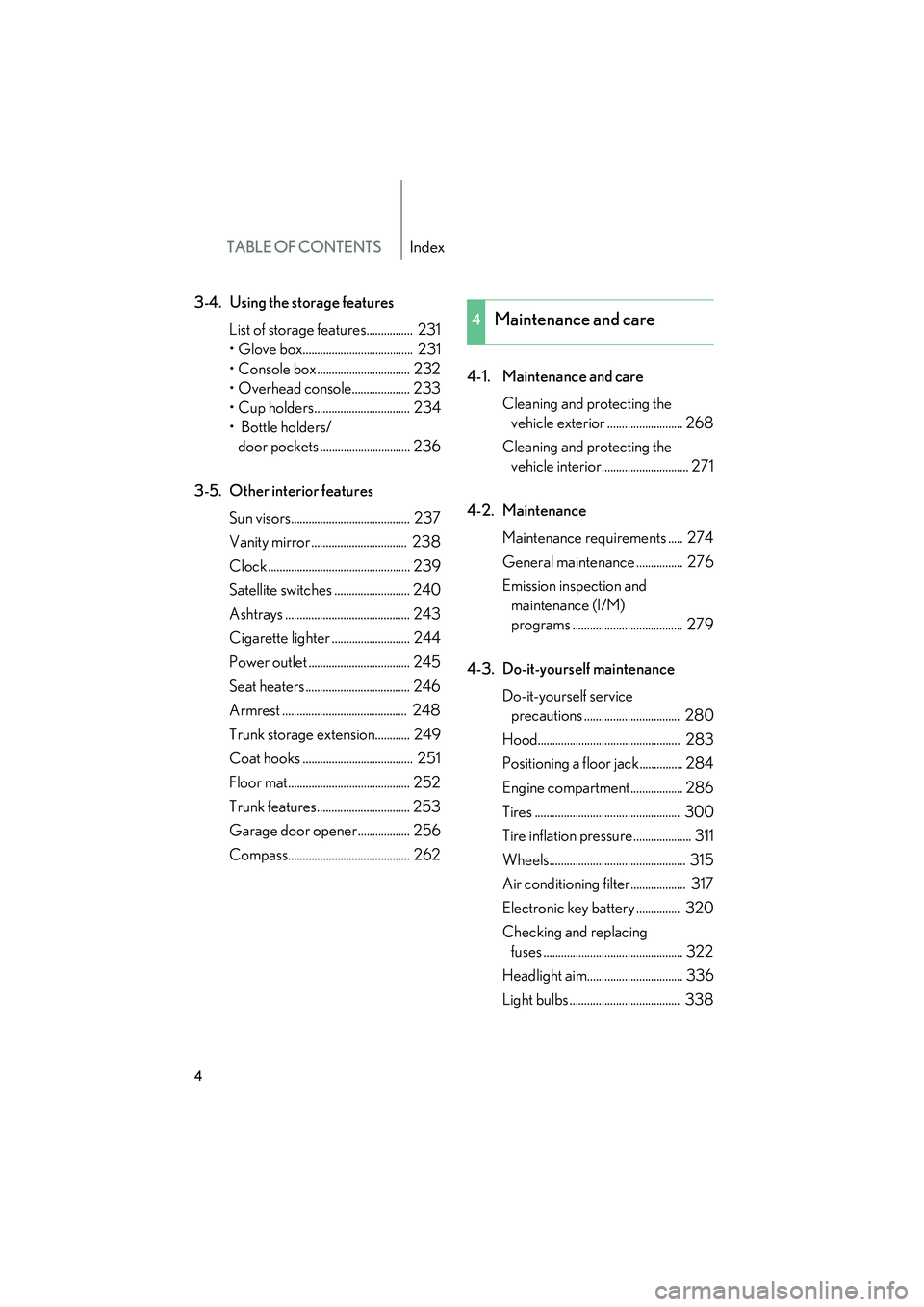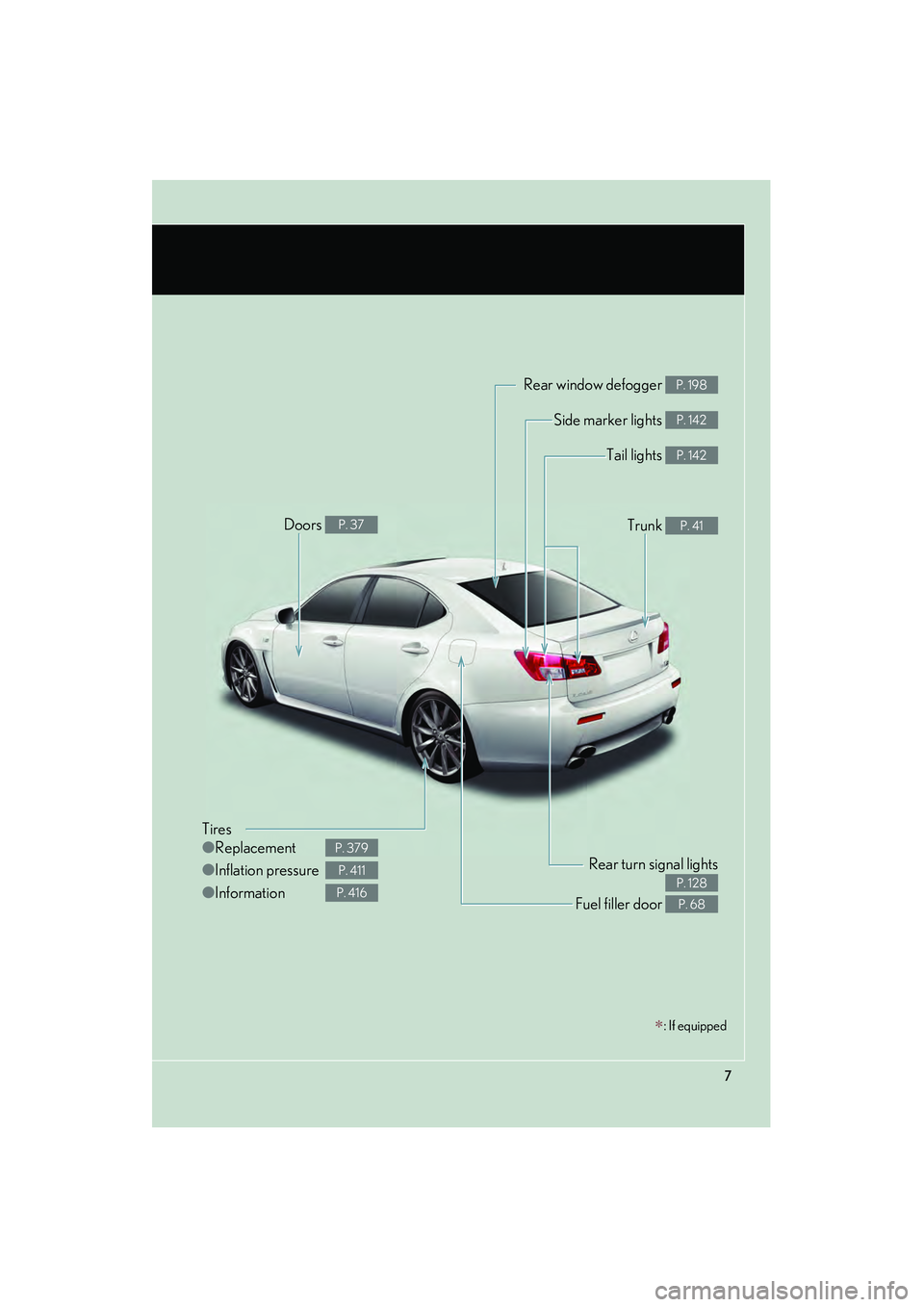2009 Lexus IS F tires
[x] Cancel search: tiresPage 5 of 458

TABLE OF CONTENTSIndex
08_IS F_U_(L/O_0808)
4
3-4. Using the storage featuresList of storage features................ 231
• Glove box...................................... 231
• Console box ................................ 232
• Overhead console.................... 233
• Cup holders................................. 234
• Bottle holders/door pockets ............................... 236
3-5. Other interior features Sun visors......................................... 237
Vanity mirror ................................. 238
Clock ................................................. 239
Satellite switches .......................... 240
Ashtrays ........................................... 243
Cigarette lighter ........................... 244
Power outlet ................................... 245
Seat heaters .................................... 246
Armrest ........................................... 248
Trunk storage extension............ 249
Coat hooks ...................................... 251
Floor mat.......................................... 252
Trunk features................................ 253
Garage door opener.................. 256
Compass.......................................... 262 4-1. Maintenance and care
Cleaning and protecting the vehicle exterior .......................... 268
Cleaning and protecting the vehicle interior.............................. 271
4-2. Maintenance Maintenance requirements ..... 274
General maintenance ................ 276
Emission inspection and maintenance (I/M)
programs ...................................... 279
4-3. Do-it-yourself maintenance Do-it-yourself service precautions ................................. 280
Hood................................................. 283
Positioning a floor jack............... 284
Engine compartment.................. 286
Tires .................................................. 300
Tire inflation pressure.................... 311
Wheels............................................... 315
Air conditioning filter................... 317
Electronic key battery ............... 320
Checking and replacing fuses ................................................ 322
Headlight aim................................. 336
Light bulbs ...................................... 338
4Maintenance and care
Page 8 of 458

08_IS F_U_(L/O_0808)
7
∗: If equipped
Tires
●Replacement
● Inflation pressure
● Information
P. 379
P. 411
P. 416
Tail lights P. 142
Side marker lights P. 142
Trunk P. 41
Rear window defogger P. 198
Doors P. 37
Fuel filler door P. 68
Rear turn signal lights
P. 128
Page 110 of 458

109
2-1. Driving procedures
2
When driving
08_IS F_U_(L/O_0808)
■Starting off on a hill
Hill-start assist control will operate. (→P. 1 6 9 )
■Driving in the rain
●Drive carefully when it is raining, because visibility will be reduced, the windows
may become fogged-up, and the road will be slippery.
●Drive carefully when it starts to rain, because the road surface will be especially
slippery.
●Refrain from high speeds when driving on an expressway in the rain, because
there may be a layer of water between the tires and the road surface, preventing
the steering and brakes from operating properly.
■Breaking in your new Lexus
To extend the life of the vehicle, the following precautions are recommended to
observe:
●For the first 186 miles (300 km):
Avoid sudden stops.
●For the first 621 miles (1000 km):
• Do not drive at extremely high speeds.
• Avoid sudden acceleration.
• Do not drive continuously in the low gears.
• Do not drive at a constant speed for extended periods.
■Drum-in-disc type parking brake system
Your vehicle has a drum-in-disc type parking brake system. This type of brake sys-
tem needs bedding-down of the brake shoes periodically or whenever the parking
brake shoes and/or drum are replaced. Have your Lexus dealer perform the bed-
ding down.
■Operating your vehicle in a foreign country
Comply with the relevant vehicle registration laws and confirm the availability of the
correct fuel. ( →P. 4 0 5 )
Page 112 of 458

111
2-1. Driving procedures
2
When driving
08_IS F_U_(L/O_0808)
CAUTION
●Do not turn the engine off while driving.
The power steering and brake booster systems will not operate properly if the
engine is not running.
●Use engine braking (downshift) to maintain a safe speed when driving down a
steep hill.
Using the brakes continuously may cause the brakes to overheat and lose effec-
tiveness. (→P. 1 2 2 , 1 2 4 )
●When stopped on an inclined surface, use the brake pedal and parking brake to
prevent the vehicle from rolling backward or forward and causing an accident.
●Do not adjust the position of the steering wheel, the seat, or the inside or outside
rear view mirrors while driving.
Doing so may result in a loss of vehicle control that can cause accidents that may
result in death or serious injury.
●Always check that all passengers' arms, heads or other parts of their bodies are
not outside the vehicle, as this may result in death or serious injury.
●Do not drive in excess of the speed limit. Even if the legal speed limit permits it, do
not drive over 85 mph (140 km/h) unless your vehicle has high-speed capability
tires. Driving over 85 mph (140 km/h) may result in tire failure, loss of control and
possible injury. Be sure to consult a tire dealer to determine whether the tires on
your vehicle are high-speed capability tires or not before driving at such speeds.
■When driving on slippery road surfaces
●Sudden braking, acceleration and steering may cause tire slippage and reduce
your ability to control the vehicle, resulting in an accident.
●Sudden changes in engine speed, such as engine braking caused by up-shifting
or down-shifting, may cause the vehicle to skid, resulting in an accident.
●After driving through a puddle, lightly depress the brake pedal to make sure that
the brakes are functioning properly. Wet brake pads may prevent the brakes from
functioning properly. If the brakes on only one side are wet and not functioning
properly, steering control may be affected, resulting in an accident.
■When shifting the shift lever
Be careful not to shift the shift lever with the accelerator pedal depressed.
This may lead to unexpected rapid acceleration of the vehicle that may cause an
accident and result in death or serious injury.
Page 176 of 458

175
2-4. Using other driving systems
2
When driving
08_IS F_U_(L/O_0808)
CAUTION
■Replacing tires
Make sure that all tires are of the designated size and total load capacity, and of the
same brand and tread pattern. In addition, make sure that the tires are inflated to the
recommended tire pressure level.
The ABS and VSC systems will not function correctly if different tires are fitted on
the vehicle.
Contact your Lexus dealer for further information when replacing tires or wheels.
■Handling of tires and suspension
Using tires with any kind of problem or modifying the suspension will affect the driv-
ing assist systems, and may cause the system to malfunction.
Page 183 of 458

182
2-5. Driving information
08_IS F_U_(L/O_0808)
CAUTION
■Things that must not be carried in the trunk
The following things may cause a fire if loaded in the trunk.
●Receptacles containing gasoline
●Aerosol cans
■Storage precautions
Observe the following precautions.
Failing to do so may result in death or serious injury.
●Do not place cargo or luggage in or on the following locations as the item may
get under the brake or accelerator pedal and prevent pedals from being
depressed properly, block the driver's vision, or hit the driver or passengers,
causing an accident.
• At the feet of the driver
• On the front passenger or rear seats (when stacking items)
• Package tray (behind the rear seatback)
• Instrument panel
•Dashboard
●Secure all items in the occupant compartment, as they may shift and injure some-
one during an accident or sudden braking.
■Luggage capacity and distribution
Observe the following precautions. Failure to do so will not only put load on the
tires, but also reduce steering and braking performance. This could lead to an acci-
dent resulting in serious injury or even death.
●Do not overload the vehicle.
●Do not apply load to the vehicle unevenly.
Page 184 of 458

183
2-5. Driving information
2
When driving
08_IS F_U_(L/O_0808)
Vehicle load limits
■Total load capacity and seating capacity
These details are also described on the tire and loading information label.
(→ P. 3 1 1 )
CAUTION
■Overloading the vehicle
Do not overload the vehicle.
It may not only cause damage to the tires, but also degrade steering and braking
ability, resulting in an accident.
Vehicle load limits include total load capacity, seating capacity, towing
capacity and cargo capacity.
■Total load capacity: 660 lb. (300 kg)
Total load capacity means the combined weight of occupants, cargo and
luggage.
■Seating capacity: 4 occupants (Front 2, Rear 2)
Seating capacity means the maximum number of occupants whose esti-
mated average weight is 150 lb. (68 kg) per person.
■Towing capacity
Lexus does not recommend towing a trailer with your vehicle.
■Cargo capacity
Cargo capacity may increase or decrease depending on the weight and
the number of occupants.
Page 185 of 458

184
2-5. Driving information
08_IS F_U_(L/O_0808)
Winter driving tips
Carry out the necessary preparations and inspections before driving the
vehicle in winter. Always drive the vehicle in a manner appropriate to the
prevailing weather conditions.
■Pre-winter preparations
● Use fluids that are appropriate to the prevailing outside tempera-
tures.
• Engine oil
• Engine coolant
• Washer fluid
● Have a service technician inspect the level and specific gravity of
battery electrolyte.
● Have the vehicle fitted with four snow tires.
Ensure that all tires are the specified size and the same brand.
■Before driving the vehicle
Perform the following according to the driving conditions.
● Do not try to forcibly open a window or move a wiper that is fro-
zen. Pour warm water over the frozen area to melt the ice. Wipe
away the water immediately to prevent it from freezing.
● To ensure proper operation of the climate control system fan,
remove any snow that has accumulated on the air inlet vents in
front of the windshield.
● Remove any ice that has accumulated on the vehicle chassis.
● Periodically check for and remove any excess ice or snow that
may have accumulated in the wheel well or on the brakes.